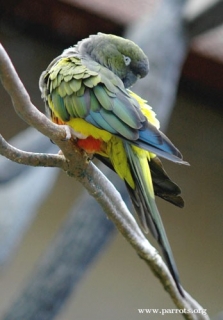Patagonian Conure |
|
|
Also known as: Patagonian Parrot, Burrowing Parrot, Greater Patagonian Conure (C.p. bloxami)
Photos
View in GalleryDid You Know?
A recent study by Masello et al found over 35,000 active nest burrows in El Condor, Argentina.Programs & Projects
WPT has worked with numerous partners to help save this species. Learn moreAcademic Research
Related publications: Cyanoliseus patagonusSpecies Profile
Genus: Cyanoliseus | Species: patagonus
Size:
45cm (17.5 in)
Weight:
256-281g (9-10 oz) (patagonus) 315-390g (11-13.6 oz) (bloxami)
Subspecies including nominate:
four: C.p. patagonus (Lesser), C.p. andinus, C.p. bloxami (Greater), C.p. conlara
Colour Adult:
C.p. patagonus: Both adults olive/brown head, neck, back and breast; lower back to tail and upper abdomen yellow; orange/red thighs and centre of abdomen; throat and breast grey/brown, white marks at bend of wing on breast; tail olive/green tinted with blue, undertail brown/grey. White bare eye-ring, eye pale yellow. Bill dark grey.
C.p. conlara: Both adults as in patagonus, but with darker breast.
C.p. andinus: Both adults duller than patagonus; little yellow on lower underparts; centre of abdomen dull orange/red; white markings on breast very faint.
C.p. bloxami: Both adults brighter yellow on lower underparts, brighter red on thighs and centre of abdomen, more extensive white on breast forming a wide band; larger in size.
Colour Juvenile:
As in adult but generally duller; shorter tail. Upper mandible horn-coloured. Eye pale grey.
Call:
Calls very noisy; shrieking; alarm call gyeee gyee gyeee.
Listen NowVideo Links:
Video 1More Information:
Content Sources:
CITES
BirdLife International
Cornell Lab of Ornithology/Birds of the World
Parrots: A Guide to Parrots of the World, Juniper and Parr, 1998
Burrowing Parrots, Masello, Juan
ML Media Collection Catalogue 146738, Burrowing Parrot Cyanoliseus patagonus, Robbins, Mark, Rio, Negro, Argentina, Nov. 17 2006, Cornell Lab of Ornithology. Site
Parrots of the World, Forshaw and Cooper, 1977. 2010 edition
Parrots of the World, Forshaw, 2006.
Parrots in Aviculture, Low, 1992.
Parrots: Their Care and Breeding, Low, 1986.
Photos
View in GalleryDid You Know?
A recent study by Masello et al found over 35,000 active nest burrows in El Condor, Argentina.Programs & Projects
WPT has worked with numerous partners to help save this species. Learn moreAcademic Research
Related publications: Cyanoliseus patagonusSpecies Care
Captive Status:
Fairly common.
Longevity:
Up to 35 yrs.
Housing:
Walk in aviary or enclosure, minimum length 4.5-7m (14.7-23 ft).
Diet:
Mix of soaked or sprouted sunflower seed; boiled maize; cooked or sprouted beans; cooked whole rice; fresh vegetables such as carrot, green beans, zucchini; fresh fruits such as apple, orange, banana separately; mix of small seeds (canary, oat), complete commercial pellet.
Enrichment:
Love bathing, puzzle toys, bird-safe woods such as fir, pine, willow, elder; other bird-safe chewables (vegetable tanned leather toys), climables (ladders, swings); noise makers, foraging toys.
Nest Box Size:
14" x 14" x 24" (35.5cm x 35.5cm x 61cm) rectangular box.
Clutch Size:
2 to 5
Incubation Time:
24-25 days
Fledging Age:
7-9 weeks (longer for bloxami)
Hatch Weight:
10-12g (0.35-0.4 oz)
Peak Weight:
Not recorded.
Weaning Weight:
225g (8 oz)
Photos
View in GalleryDid You Know?
A recent study by Masello et al found over 35,000 active nest burrows in El Condor, Argentina.Programs & Projects
WPT has worked with numerous partners to help save this species. Learn moreAcademic Research
Related publications: Cyanoliseus patagonusSpecies Wild Status
World Population:
Around 95,000 mature individuals.
IUCN Red List Status:
Least Concern
CITES Listing:
Appendix II
Threat Summary:
Heavily trapped for wild bird trade; since 1981, greater than 100,000 individuals have been recorded in international trade. Also persecuted as a crop pest and at threat from the destruction of breediing colonies. The population size of the four subspecies was estimated as follows by Masello et al. in 2011: patagonus 43,330 nests, conlara 1,700 individuals, andinus 2,000 nests, bloxhami 5,000-6,000 individuals.
Range:
C.p. patagonus: S Argentina, ranging north in winter to C Argentina and S Uruguay.
C.p. conlara: C Argentina.
C.p. andinus: NW Argentina, from Salta and Catamarca south to C Mendoza and N San Luis.
C.p. bloxami: formerly C Chile, but now restricted to a few localities in central provinces, including Bio Bio.
Habitat:
Found in open grass country, also reported in savanna, wooded valleys with cliffs and farmland to about 2000m (6560 ft). In arid country near streams and rivers.
Wild Diet:
Diet is chiefly seeds taken from the ground; also shrubs such as giant thistle Carduus mariana, berries and fruits such as Geoffroea decorticans, Prosopis, Schinus, Empetrum rubrum, Lycium salsum, Discaria and cacti; also seeds of Nothofagus obliqua and Cordia decandra in the Andean foothills of C Chile.
Ecology and Behaviour:
Gregarious parrots, forming large flocks in excess of 1000 birds; roosts communally in trees, wires, and in nest tunnels.
Clutch and Egg Size:
2 to 5 almost spherical eggs, 36.5 x 29.5mm (1.4 x 1.1 in).
Breeding Season:
September-February. Nest is in burrow in sandstone, limestone or earth cliff, often by river or body of water.
Related Links:
Photos
View in GalleryDid You Know?
A recent study by Masello et al found over 35,000 active nest burrows in El Condor, Argentina.Programs & Projects
WPT has worked with numerous partners to help save this species. Learn moreAcademic Research
Related publications: Cyanoliseus patagonusMembers Only Resources
Please log-in now to find more research, resources and tools.
Not a Member?
Find more great information:
Gain exclusive access to 600+ pages of additional research, seminars and podcasts, specialists to ask your toughest questions, and dozens of other fun resources - when you become a WPT member.
Join Today >>

































